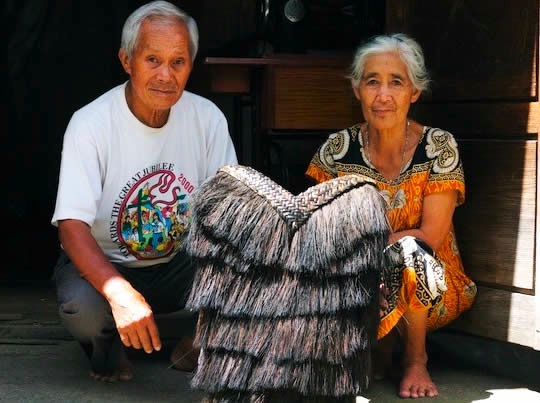Remember the picture I posted of Aklay (aka Philippe) the French Baker in Sagada wearing one of those water-proofed traditional backpacks? I found it (well, both Aklay and the backpack) interesting and posted a photo of them on my Flickr.
I’d actually secured a standard variety model without the covering a week earlier, but when Roman Izdebski, a professor of mine at ECI, saw the covered version he expressed the hope that I could find one to bring back to the school. So with that I went back to Sagada (town in Mountain Province, Philippines) this past weekend to get one.
Sagada didn’t have any but I was recommended to try Banaue (town of rice terrace fame), which is where I found and purchased this one. Unfortunately, no one can say for sure who made it, or when. All the details I could gather are below.

Front and side views of the hunter backpack or bango.
Everyone I encountered verified that this design is specifically associated with hunters. Traditionally it was worn to carry goods and equipment and also, even if carrying nothing, as just a rain coat. The entire bag portion is woven rattan. The water-proof covering is made from the extracted fibres of a very long-leafed pineapple plant. Other varieties of this pack (which I did not find) can also use fur for the covering. What I do know is that this particular pack was found / purchased by the Banaue shop owners in the more distant village of Cambulo.
There are many terms for this kind of pack. The general umbrella term used in the Cordillera is a ‘pasiking’ (http://www.pasiking.com/). Without the covering they may be called ‘sangi’ or more commonly ‘bango’ in various Ifugao regions.

Here Benjamin Tanggana (aka Jun), the knowledgeable local guide who helped me find the pack, tries it on. Jun is an accredited guide and can be contacted at the Banaue Tourist Office.

The shop owners in Banaue that sell the hunter packs.
The shop owners are Elena and Pedro Dinalnog (pronounced Dee-nal-no). Pedro is the one who visits small towns to collect these artefacts and goods. I paid P900 (approx. $21 CAN) for this hunter pack. Note this one pictured is darker than the other because it was used for longer.
Traditionally these packs were hung inside an Ifugao home, where the soot from the fire would eventually turn it black while simultaneously helping to preserve it. Note that while you see many people wearing the traditional backpack without the water-proof covering, I have not seen anyone wearing this hunter pack variety (except Aklay the French Baker, which, incidentally, some elders frown upon).
Finally, some tribes or families use this or similar pack designs as a ‘takba,’ a sacred object in their home. The takba represents a sort of spirit that is linked to the family. If the takba is not kept clean or safe in the home for all to see, a family member may become sick. Rice, rice wine and other preserved foods are often kept in the takba though the takba is never actually used as a backpack. It is usually stored on a shelf, or hung on a wall.
Every takba has a name and the object itself is passed down from generation to generation with any needed repairs done to the pack. Often one will ask a family about how their takba is doing. Bang, the 22-year-old son of the Inn owner I stayed with told me all this, also noting his family has had a takba for four generations.






Leave a Reply